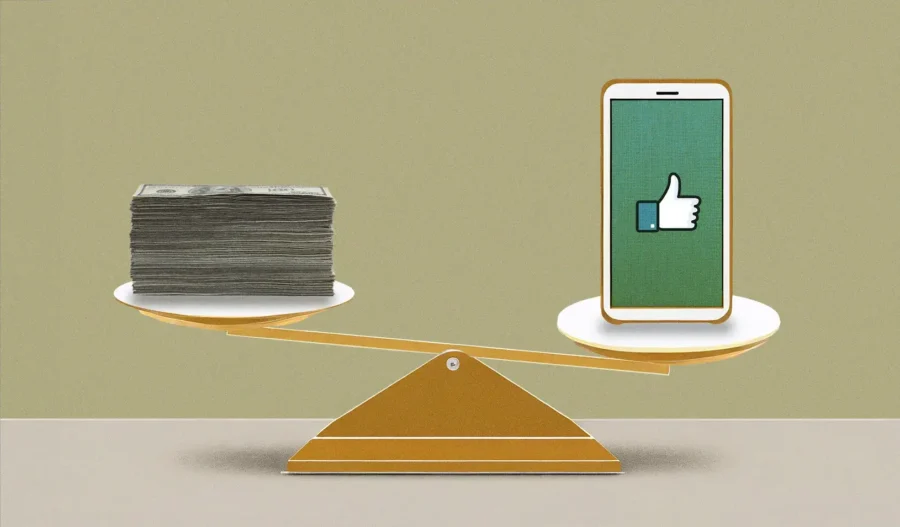How much would someone have to pay you to stop using Facebook for a month: $5? $10? $100? That’s the question Erik Brynjolfsson and his fellow researchers posed to nearly 40,000 Facebook users from 13 countries. It turned out that less than one-fifth would stay away in exchange for five bucks, while more than three-fourths would abstain for $100.
These findings were part of an experiment designed to shed light on the value of digital goods — the plethora of virtual products that have become a fixture of daily life, from video streaming platforms to messaging apps and e-commerce sites. Despite the benefits they bring consumers, most digital goods are free. That means they’re largely overlooked in calculations of gross domestic product, which, with few exceptions, is based on the price people pay for goods and services.
The limitations of GDP are well documented — the metric ignores the value of everything from antibiotics to clean air to doing your own laundry. Brynjolfsson is among those who say a new, broader set of metrics is needed now that the average American spends almost 24 hours a week online.
“You can’t manage what you can’t measure,” says Brynjolfsson, a professor (by courtesy) at Stanford Graduate School of Business, as well as the director of the Stanford Digital Economy Labopen in new window and a fellow at the Stanford Institute for Economic Policy Researchopen in new window. “If you don’t know where value is being created in the economy, you’re going to make bad decisions as policymakers, as executives, and as citizens.”
The experiment, described in a National Bureau of Economic Research working paper, estimated the value of Facebook and nine other digital goods: Twitter (now X), Instagram, WhatsApp, Snapchat, TikTok, Google Search, Google Maps, YouTube, and Amazon Shopping. Brynjolfsson and his coauthors, who included Stanford postdoctoral scholar Jae Joon Leeopen in new window, ranked the relative benefit people derived from these sites based on how willing they would be to stop using them for a month.
People preferred Google Search the most — even more than meeting friends in person — followed by YouTube and Google Maps. Twitter and Snapchat were the least preferred services, while Facebook was somewhere in the middle. The researchers used their findings on how much money people would accept to stop using Facebook to extrapolate the dollar value of other products. The study was conducted in partnership with Meta, the parent company of Facebook, Instagram, and WhatsApp; the company had no veto over published results.
The study concluded that just these 10 digital goods produced more than $2.5 trillion in value annually, the equivalent of around 6% of total GDP across the 13 countries included in the study. “The magnitude of the effect was striking,” Brynjolfsson says. “It tells me that measuring the value of digital goods is not just a theoretical exercise: This is making a first-order difference in billions of people’s lives.”
A New Way to Gauge GDP
The research also found that countries with lower GDPs, such as Mexico and Romania — and lower-income people within each country — derived proportionately more value from digital goods than their wealthier counterparts. “At first I thought that was sort of surprising, but then I realized, if you don’t have much money, it makes sense to consume and get a greater benefit from free goods,” Brynjolfsson says. “That means an important implication is that digital goods tend to reduce inequality within countries and between countries.”
In earlier research, Brynjolfsson and his colleagues estimated the value of several digital goods, including Facebook and smartphone cameras. The latest study covered a larger basket of products and included a much bigger sample of people from a broader geography. Next, his team at the Stanford Digital Economy Lab will undertake a massive study to measure the value of over 800 goods: not only digital products but also more traditional goods and services such as toothpaste, cars, and health care. “Even with something like toothpaste, the consumer value may be very different from the price you pay,” Brynjolfsson says.
Brynjolfsson is using this research to help establish a complementary metric to GDP called GDP-B, which measures how much goods contribute to people’s welfare, not how much they cost. This spring, the Digital Economy Lab is organizing a workshop with representatives from the U.S. Bureau of Economic Analysis, which tracks GDP, and comparable agencies from other countries to discuss the new framework. “I’m hopeful they’ll start adopting GDP-B alongside traditional GDP,” Brynjolfsson says. “Instead of just measuring how much you spend on things, this measures the benefit you’re getting from them, which is going to be a more interesting and relevant concept for a lot of purposes.”
A more expansive measure of value could provide a more robust foundation for decisions about everything from R&D funding to economic legislation, Brynjolfsson says. It could also inform measures to curb inequality. “If you want to further reduce income inequality, one tool is improving the nation’s digital infrastructure so more people have access to free digital goods,” he says.
As more of our lives shift online, Brynjolfsson believes it will become even more important to account for what we get out of “digital things made of bits” and not just “physical things made of atoms”: “If we don’t, eventually we’ll be missing almost the whole ballgame.”
https://www.gsb.stanford.edu/insights/how-much-your-favorite-free-app-worth-you


